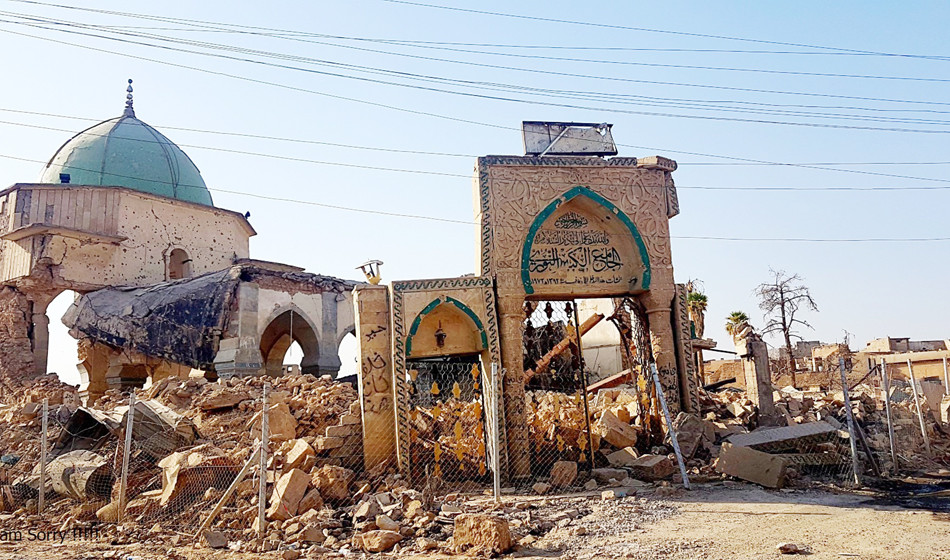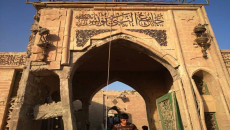On the western side of Mosul and at the heart of the old town, the ruins of Al-Nouri Grand Mosque and its minaret al-Hadba await renovations.
The new design approved the United Nations Educational, Scientific and Cultural OrganizationUNESCO has trigged controversy as some criticize it for changing its original Moslawi design and touches while others support modern renovation.
“The cultural sites were not renovated except some such as Al-Nouri Grand Mosque, al-Hadba Minaret, few other mosques and churches, assistant of Ninewa archeological inspector.
The extremist militants of the Islamic State in Iraq and Syria ISIS have blown up about 150 archeological sites from August 2014 up to July 2017, figures by Ninewa Archeology office.
Footage of blowing Al-Nouri Grand Mosque and al-Hadba Minaret in 2017
Revive the spirit of Mosul
In February 2018, the Director-General of UNESCO, Audrey Azoulay, launched the flagship initiative “Revive the Spirit of Mosul” as the Organization’s response for the recovery of Mosul, one of Iraq’s iconic cities, sponsored by the United Arab Emirates UAE.
“Reviving Mosul is not only about reconstructing heritage sites, it is about empowering the population as agents of change involved in the process of rebuilding their city through culture and education,” the UNESCO says.
“Reconstruction will succeed and Iraq will regain its influence only if the human dimension is given priority; education and culture are the key elements. They are forces of unity and reconciliation,” said Audrey Azoulay, Director-General of UNESCO.
“It is through education and culture that Iraqis, men and women alike, will be able to regain control of their destiny and become actors in the renewal of their country.”
An international jury on April 15th announced that an entry by eight Egyptian architects won the international competition for the reconstruction of the historic Al-Nouri Mosque complex in Mosul, Iraq, a major component of UNESCO’s ambitious project for the rehabilitation of the ancient city, Revive the Spirit of Mosul.
Selected from among 123 entries, the winning design for a “Courtyards Dialogue,” as the winning project is called, was presented by a team of four partners from Egypt chaired by Salah El Din Samir Hareedy.
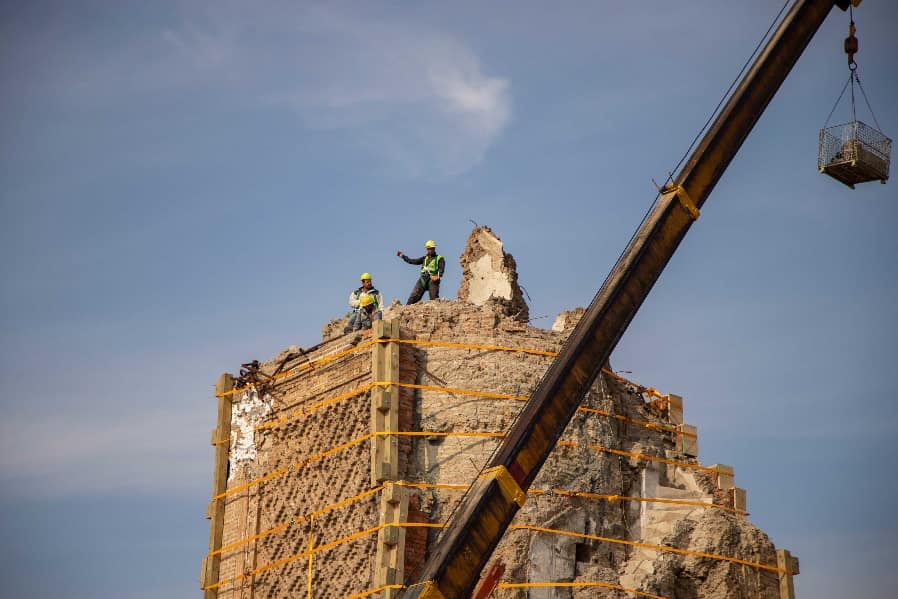
The design approved by the UNESCO is rejected by some conservative people of Mosul and activists arguing it's far away from the original version, inspired by foreign designers who have no idea about the spiritual relation between the mosque and the locals.
Tahani Salih, an activist and blogger, dislikes the new design saying the UNESCO "severely overlooked the Mosulawis and their vision for rebuilding the mosque."
"One of the standards of rebuilding a historical site is involvement of the locals and taking their opinions into consideration while the UNESCO took the decision by itself despite all objections," she added.
She wondered why it has decided to adopt the original versions of al-Tahira and the Latin churches while it has chosen a very modern design for an old mosque.
On the contrary, Ayoub Dhanoun, a civic activist, approves renovation of the mosque and keeping the minaret as it was. "Some Mosulawi touches to reflect its originality won't hurt."
Al-Nouri Grand Mosque was built in the 11th century which has been renovated several times across history yet the minaret has kept its original form.
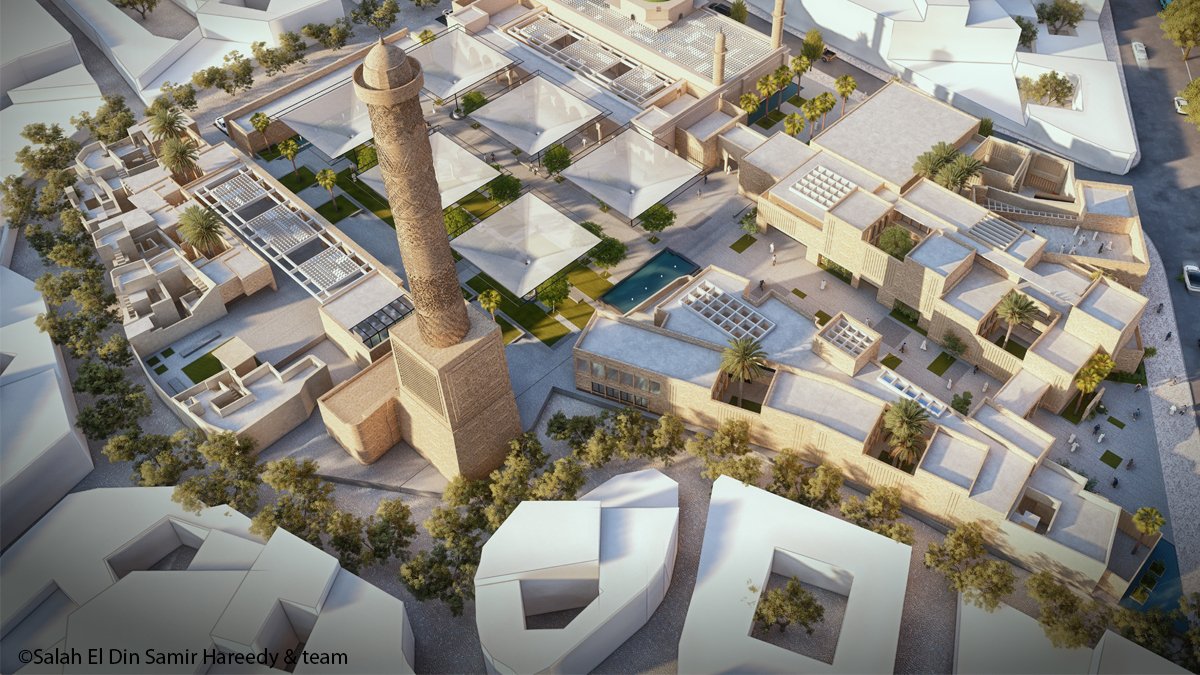
The project foresees the reconstruction of Al-Nouri’s historic prayer hall and the organic integration of the complex, the largest public space in the Old City of Mosul, in its urban surrounding through open public spaces with five entry points from surrounding streets.
While the prayer hall will look as it did before the 2017 destruction of Al-Nouri Mosque, it will feature notable improvements in the use of natural light and expanded spaces for women and dignitaries, that will connect to the main hall through a semi covered open structure which could also serve as an open space for prayer.
The winning project further foresees the creation of enclosed gardens evocative of the historic houses and gardens that were located around the prayer hall prior to its remodeling in 1944.
Upon notification of their winning, the team issued a statement welcoming the results of the competition saying “Our team worked with high passion to submit a project that primarily addresses the need for social cohesion and revival of souls. We are looking forward to completing the design and to helping the revival of the Old City of Mosul,” UNESCO quoted the team.
Ammar Al-Ali, a civil servant for Ninewa religious endowment in Ninewa said he understands the concerns of the Muslim Sunni community as the new project includes yards, school, halls and greenery.
Al-Ali said the Sunni endowment has been awarded "a coordination not a practical role."
The mosque and the minaret were blown up by the extremist militants of the ISIS on July 21st 2017 when they were besieged by the Iraqi security forces ISF.
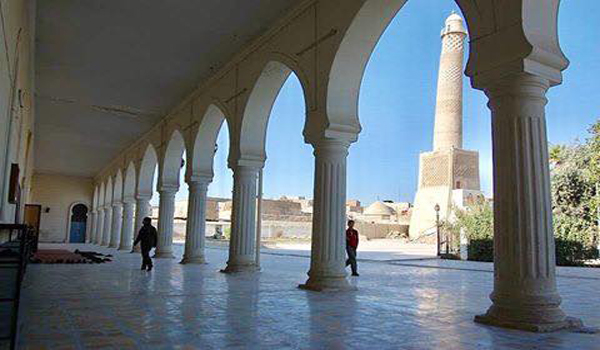
Al-Nouri grand mosque before befoe blowing it up.
In the old city, there are 365 cultural heritage sites that have existed throughout different eras and civilizations. Al-Hadba Minaret and Great Mosque of al-Nuri are two historic sites of the city that were blown up by ISIS.
Another landmark of Mosul is the mosque and shrine of Nabi (prophet) Yunus which was built at the top of a 40- meter hill called Tuba (brick) Hill, while archeological researches argue it has been built upon an Assyrian palace for King Esarhaddon, son of Sennacherib and grandson of King Sargon, who ruled the Neo-Assyrian Empire (681-669 BC).
On June 10th 2014, the Islamic State in Iraq and Syria ISIS seized Mosul, the capital of Ninawa and the largest city of the province, a month and half later, the extremist militants have detonated the Nabi (prophet) Yunus Mosque on July 24th 2014.
Locals in Mosul eagerly look for rebuilding the historical and religious landmarks of the city, a sign of revival and reconstruction in the war-ravaged city.

